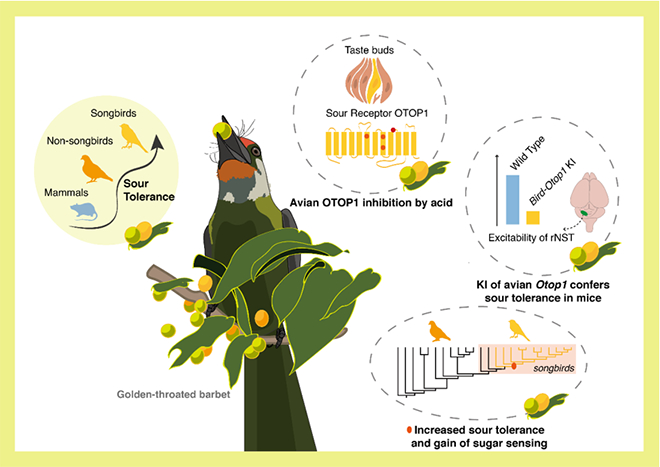Chinese scholars and overseas collaborators make progress in the field of environmental adaptation mediated by the evolution of avian sour taste perception function

Figure: The mechanism of environmental adaptation mediated by the evolution of the sour taste perception function in birds
Supported by the National Key Research and Development Program of China and National Natural Science Foundation of China (Grant No. 32370538, 31930015), a collaborative research, led by Professor Ren Lai from the Kunming Institute of Zoology, Chinese Academy of Sciences and Professor Maude W. Baldwin from the Max Planck Institute for Biological Intelligence in Germany, has revealed that birds achieve sour tolerance through the adaptive evolution of sour taste receptor. Their findings, published online in Science (https://www.science.org/doi/10.1126/science.adr7946.) on June 19, 2025, under the title "Molecular evolution of sour tolerance in birds", illuminate how avian species have evolved sophisticated taste receptor mechanisms to exploit acidic food sources that would be prohibitively unpalatable to other vertebrates.
The evolutionary refinement of nutritional perception in birds has been instrumental in enabling their dietary flexibility and successful colonization of diverse ecological niches—a key driver of species diversity. Fruits, as an important source of energy, are widely consumed by birds, particularly during periods of food scarcity and migration. Despite the long-standing and extensive interaction between birds and fruits, the question of how birds perceive and tolerate the high concentrations of organic acids in fruits remains unanswered.
OTOP1 is recognized as a sour taste receptor, but the lack of relevant agonists or inhibitors has limited the study of its acid response mechanisms. The previous work of the Ren Lai team identified several biotoxin molecules that can inhibit or activate OTOP1, laying the foundation for studying the mechanisms related to acid response of OTOP1. The recent research found that avian OTOP1 is inhibited by acid at low pH, reducing the generation of sour taste nerve signals and the associated physiological responses, thus reducing the discomfort caused by the high concentration of organic acids in fruits. To validate these molecular findings, the researchers employed transgenic approaches, creating mouse models with bird OTOP1 gene knock-ins. These mice exhibited significantly reduced neural responses to acid stimuli. Further confirmation came from pharmacological intervention conducted on pigeons and canaries, where targeting the sour taste receptor OTOP1 of significantly weakened their sour tolerance, confirming the critical role of this receptor in avian sour taste perception and sour tolerance. Detailed molecular analysis identified four key amino acids (H239, L306, H314, G378) that confer acid-inhibitory properties to the avian OTOP1. Notably, a single amino acid residue mutation (G378) in the songbird OTOP1 further enhances their acid tolerance beyond that observed in non-songbird. Reconstruction of ancestral avian sour taste receptors suggests that the enhanced sour tolerance in songbirds may have co-evolved with the acquisition of sweet taste perception, potentially driving dietary diversification and facilitating environmental adaptation and broader ecological niche occupation.
This study not only reveals the subtle mechanism of how animal senses adapt to the environment, but also provides clues for understanding the co-evolution between birds and plants and their environmental adaptation, deepens the understanding of avian radiation evolution, and provides new insights into the functional evolution of sensory receptors to adapt to the survival of birds.
Contact Us

National Natural Science Foundation of China
Add: 83 Shuangqing Rd., Haidian District, Beijing, China
Postcode: 100085
Tel: 86-10-62327001
Fax: 86-10-62327004
E-mail: bic@nsfc.gov.cn
